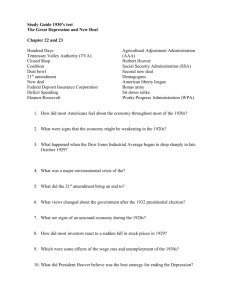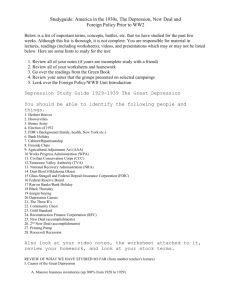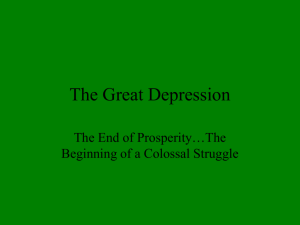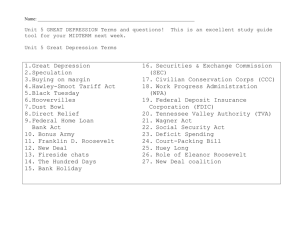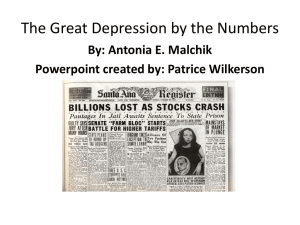The 1930s - verbetensocialstudies
advertisement
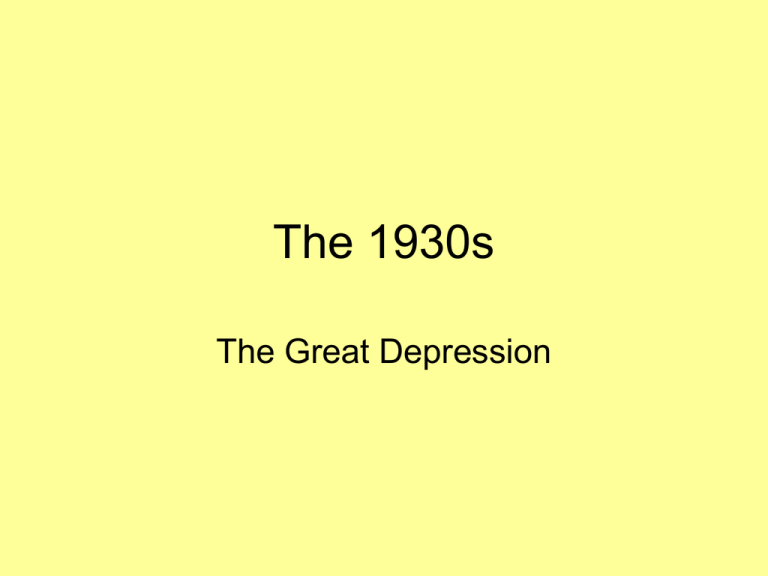
The 1930s The Great Depression The Stock Market Crash 1. Black Thursday – October 24,1929 A. Interest rates up B. Investors sold shares C. Prices of stocks plunged 2. Black Tuesday – October 29,1929 A. Prices dropped to an all-time low B. Investors sold over 16 million shares of stock 3. To cover loans, investor HAD TO sell stock for huge loses. Roaring 20s vs Depression The Depression Begins 1. Late 1929 – 1933 the US economy sank A. B. C. D. GNP in 1929 = $103 billion; 1933 = <$56 billion Incomes were cut in ½ Factories, RRs, businesses were shut down Millions were unemployed 2. 1930 – 1932 over 5000 banks failed A. No incoming funds B. People panicked and withdrew their savings C. Customers lost life-savings What Caused the Great Depression? 1. Global Economic Downturn A. US put high tariff on imported goods B. Smoot-Hawley Tariff of 1930 2. Debt – economic practices of the 20s created long-term problems A. Credit B. Interest rates increased C. Margin Buying (see next slide) Margin Buying • Margin buying: when a stock buyer pays for a stock with a down payment and takes a loan out for the remainder of the price • The buyer hopes to sell the stock when it increases in price • The buyer will then pay back the loan and make money as well 3. Unequal Distribution of Wealth A. The richest 1% of the population’s income grew by 63%, the poorest 93%’s decreased by 4% B. Majority had no buying power 4. Overproduction A. Natural business cycle creates recession, depression The Business Recession or Cycle depression Cut back production; lay off workers Industries increase production and hire more workers Surplus piles up The 1930s Effects of the Great Depression Employment Trends 1. 2. 3. 4. ¼ of the work force lost their jobs. Wages fell dramatically Immigration to te US decreased Blacks suffered first; 25-40% of Af Ams had no jobs by 1933 5. The % of women in the workforce increased Life in the City 1. Federal Government did little; Aid came from: A. Local governments B. Charitable organizations (Red Cross) C. Neighbors 2. Food Shortages A. Breadlines B. By 1932 1 of 5 kids in NYC were malnourished • Long-term effects: stunted growth, weak bones, dental problems Photograph of a Breadline in New York City During the Great Depression Depression: Breadlines: long line of people waiting to be fed: New York City: in the absence of substantial government relief programs during 1932, free food was distributed with private funds in some urban centers to large numbers of the unemployed. (Circa February 1932) 3. Homelessness A. Shantytowns were built outside city B. Blaming Hoover, they became known as “Hoovervilles” and newspapers they slept under were “Hoover Blankets” Life on the Farm 1. Farmers of the Midwest had SURPLUS A. Crops were rotting in the fields B. Had to slaughter cattle because could afford to feed C. Banks foreclosed many farms Neighbors would help – at auctions they would buy equipment at very low prices ($.25 for a plow) 2. Tenant farmers from the South suffered from lack of food b/c poor soils, no $ 3. Migrant workers in the SW were forced to return to Mexico A. In the 1930s, 500,000 returned to Mexico B. If stayed faced severe discrimination, poor working conditions Depression’s Impact (in billions) Consumer Spending Food 1929 1933 $19.5 $11.5 Automobiles $2.6 $0.8 Value of Shares on NYSE $89.0 $19.0 Depression’s Impact on Banks Banking Industry 1929 1933 # of Banks 25,568 14,771 Volume of Stocks Sold 1.1 Billion 0.65 Billion Personal & Corporate Savings $15.3 Billion $2.3 Billion The 1930s Daily Life Family Life 1. Some families united A. Shared food and $ B. Doubled up in homes C. Young adults moved back in with parents 2. Other families broke apart A. B. C. D. E. Divorce rates ↓ Birth rates ↓ Marriages were delayed Suicide rate ↑ (28% more in ’32 than ’29) Abandonment ↑ (1.5 million were left along) 3. Women faced greater challenges of keeping the family together A. Relied on old crafts B. Took jobs outside the home C. Daily chores were a challenge Popular Culture 1. Inexpensive pastimes were popular 2. Movies A. Survival was the theme; gangster, women were often the main characters B. Musicals C. Comedians: Marx Brothers D. Cartoons: Mickey Mouse and Donald Duck http://www.lambiek.net/artists/d/disney/mi ckey_postcard2.jpg http://www.loc.gov/exhibits/bobhope/imag es/vcvg25.jpg 3. Radio was free and at home A. # of ↑ ; 12 – 28 million in the 30s B. “Shows” were broadcasts (Orphan Annie) 4. Literature A. Magazines, comic strips presented heroes: Tarzan, Superman B. Reader’s Digest was the #1 selling mag. C. Novels were escapist and reality 5. Baseball – open to page 681 of OLD BOOK http://www.redboots.net/comic s/supe_history.htm http://www.redboots.n et/comics/powers_cos tume.htm http://www.tarzan.com/bib/tidjah5.jpg The 1930s Hoover’s Failures Hoover’s Philosophy 1. Did not believe in direct federal relief. It created: • • • Vast bureaucracy Large federal budget deficit Low self-respect 2. Rugged Individualism = relief comes from individual effort and private enterprise Why it failed? Put the burden on local communities and private enterprises 3. Committee for Unemployment Relief (1930) Why it failed? Just urged Americans to donate to charity Boosting the Economy 1. Hoover did have a more active role in stimulating the g’vt than the Republican presidents 2. White House Conference A. Mtg of top business, labor, and political leaders; Hoover asked them to maintain employment, wages B. Gave optimistic statements Why it failed? All talk, no change… Hoover’s Programs 1. $800 million Public Works Programs A. Hoover Dam B. stimulate economy C. make jobs 2. Programs to help Farmers A. Agricultural Marketing Act of 1929 Why it failed? Farmers refused to produce < B. Home Loan Bank Act of ’32 3. The Reconstruction Finance Corporation (RFC) Feb 1932 A.Lent $ to RRs, insurance companies, banks B.Goal = stop bank failures, create jobs Why it failed? Ignored small bussiness, Too little too late… Strikes 1. Rural Violence A. Used violence to scare away foreclosure officials B. Destroyed crops and blocked 2. Bonus Army A. WWI veterans went to Washington, D.C. to support the “Bonus Bill” and get $ early B. Congress vetoed the bill C. Men stayed D. Army was sent in to remove veterans E. The nation’s hatred for Hoover increased The 1930s The New Deal: Restoring the Hope 1932 Election FDR’s leadership was encouraging 1. Promised government activism 2. He had an optimistic personality when delivering his 16 fireside chats 3. > 450,000 letters were sent to the White House w/in weeks; an average of 5-8000 /week throughout the 30s. Hundred Days 1. Immediately after taking office FDR called Congress into session. 2. Over the next 100 days they passed 15 pieces of legislation. 1st Concern: The Banking Crisis 1. March 6, 1933, FDR declared a bank holiday 2. The Emergency Banking Act, March 9 3. Federal Deposit Insurance Corp., June 1933 Farmers 1. Farm Credit Administration, March 28 2. Home Owners Loan Corp. (HOLC) Unemployment 1. Federal Emergency Relief Administration (FERA), May 1933 2. Civil Works Administration (CWA) 3. Civilian Conservation Corps (CCC), 1933 Economic Recovery 1. National Industrial Act (NIRA) A. Public Works Administration (PWA) B. National Recovery Administration (NRA) 2. Tennessee Valley Authority (TVA), May 1933 1936 Election FDR’s New Deal • 1st New Deal Program (1933 – 1934) – Tennessee Valley Authority (TVA) – Public Works Administration (PWA) – Securities and Exchange Commission (SEC) • 2nd New Deal Program (1935 – 1938) – Works Progress Administration (WPA) – Social Security Act Legacy of the New Deal 1. Expanded the government 2. US became a “welfare state” (take care of the people) 3. Saw poverty as an economic problem 4. Supported the Arts The 1930s Militarism in Japan Japan After WWI 1. Expanded territory A. East Asia – Korea, Taiwan B. China – Twenty-One Demands C. Germany’s Pacific Islands north of the Equator 2. Third largest navy in the world 3. Bitter toward the West A. Felt unequal. B. 1924 - U.S. banned Japanese immigration. C. The West did not support Japan’s policy in China. Social & Political Tensions Rise 1. 2. 3. Population Explosion Rapid industrial growth created > need for raw materials; forced to look elsewhere. Social and political changes bring problems. A. B. C. D. E. F. Working class more important Labor unions increased in membership, power Urban middle class grew. Western influences become significant. need for more and better education. 1925 universal male suffrage increased voting population (3-14 million) 4. Political weakness becomes evident. A. Power = nobles and industrialists. B. Hirohito had military leaders who were against democratic reforms. C. Antidemocratic nationalists grew in strength in ’30s D. Prime Minister Hamaguchi was assassinated in Nov. 1930. E. Workers and farmers began looking toward military leaders for order. 5. Militarism in Daily Life A. Supporters of the military opposed Western influences B. Favored traditional Japanese practices. C. Young children learned military drills in schools. Military Expansion 1. Sept. 1931 Japanese military invade Manchuria w/o government approval. 2. In the ‘30s, the military used violence against the government. A. 1932 – Assassinated a prime minister. B. 1936 – Army revolt that failed. 3. By 1937 the army and government had become one. 4. Fearing he would lose his power, Hiroshito gave no strong opposition. 5. The goal of the military leaders was to conquer all of Asia The 1930s Rise of Fascist Italy Totalitarianism 1. Goal = total control over every aspect of citizen’s lives 2. Individual was seen as a servant to the state with few personal freedoms 3. Used propaganda in books, radio, films, the arts, and schools to promote The Rise of Fascism in Italy 1. Nationalists were displeased A. Italy was not given territory from Central Powers. B. No work for returning veterans. C. Workers went on strike or took over factories. D. Those in power were terrified E. Peasants seized the land, inspired by the Russian Revolution. F. G’vt split into factions and was powerless 2. The Rise of Benito Mussolini A. Working-class background B. Was a journalist when younger, who supported Socialism C. During WWI he became a nationalist. D. In 1919 he form the Fascist Party. http://www.dhm.de/lemo/html/biog rafien/MussoliniBenito/ 3. Political System of Fascism A. B. C. D. E. F. Glorifies the state at all costs, even war. Authoritarian government that is NOT communist Antidemocratic Aggressive nationalism Gives the state absolute authority. Defends private property and the class structure. 4. Compared to Communism • Similarities – Flourished in hard economic times by promoting social change – Dictators, part elite claim to rule in the name of national interest • Difference – Comms want world revolution while fascists pursue nationalist goals – Communists won support of working class; fascists of business leaders, wealthy landowners, the lower class 5. Appeal of A. Promised a strong stable government B. Revived national pride C. Projected a sense of power and confidence at a time of disorder, despair Mussolini’s Road to Power 1. Conditions got worse after WWI. 2. Mussolini = “a little something for everyone.” He promised: A. Landowners → protect private property. B. Workers → full employment, workers’ benefits. C. Nationalists → to restore Italy to its former greatness. 3. Blackshirts used attacks against opponents and drove them from office, starting in ’22. 4. Oct. 1922 the Blackshirts seized Rome w/ no protest from King Victor Emmanuel II 5. The cabinet resigned and Mussolini was named Prime Minister. Mussolini’s Dictatorship 1. Ended democratic rule 2. Established a corporate state (representation w/ industry, not political parties) A. Banned non-Fascist parties. B. Syndicates - corporations of workers and employers that sent representatives to a legislature in Rome to set policies. C. Strengthened Mussolini’s power. 3. Opposition was persecuted 4. Successes: A. B. C. D. Built up the military, ending unemployment Rekindled patriotism and nationalism Used all economic and human resources to rebuild Italy. Totalitarianism True or False? 1. The individual is seen as a servant of the state 2. The individual’s only concern is providing for him/herself. 3. Art is used to promote the government. 4. Films were used to promote the government. 5. Education was free of political teachings. 6. This type of government grew out of WWI. 7. Western democracies supported totalitarianism. 8. Democratic governments used this type of government during WWI. Germany Upset with Treaty of Versailles 1. Limited the size of army 2. Required a democratic government 3. Reparations - $35 billion A. French occupation of the Rhur Valley in 1923 B. Inflation Weimar Republic 1. 2. 3. 4. Few believed in democracy 1919 voted on a national assembly Weimar Republic 1919 – 1933 1920 nationalist army tried to overthrow A. Felt betrayed B. Suppressed but opposition continued Rise of Nazism 1. National Socialist Workers’ party (Nazi) 2. Adolf Hitler 3. Brownshirts – private army of veterans and street thugs 4. 1923 – tried to lead a revoltuion but failed 1. Arrested 2. Mein Kampf blamed Jews, Communists; “Master Race” 5. Depression of 1929 made him popular 6. 1933 became prime minister (Legally) Hitler in Power 1. 2. 3. 4. Goal = Totalitarian state Reichstag burned b4 elections; Hitler blamed communists Nazi-dominated Reichstag voted Hitler emergency powers to deal w/ “Communist threat” Crushed opposition A. B. C. 5. Political parties banned Constitutional rights ended Government took over industry, churches Attacks on Jews A. B. C. 1935 Nuremberg Laws Kristallnacht Night of Long Knives The Third Reich 1. 2. 3. 4. Now had complete power; der Fuhrer His government = Third Reich Restored military strength Controlled the arts and intellectuals; many left A. Sigmund Freud B. Albert Einstein 5. Youth organizations
